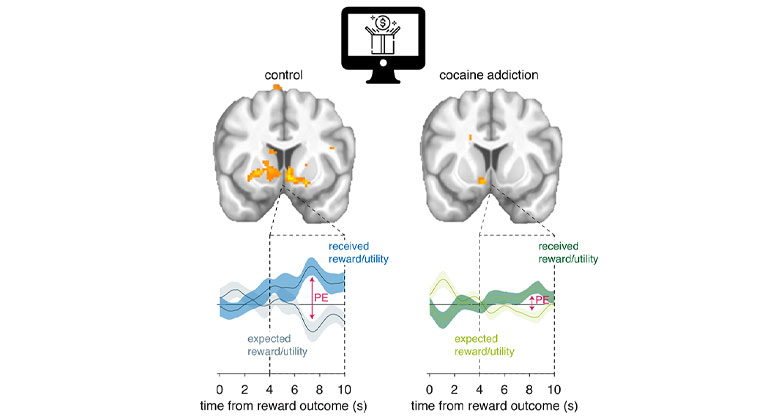Mount Sinai Researchers First to Measure the Brain’s Electric Activity to Pinpoint When Cocaine-Addicted Individuals Are Most Vulnerable to Relapse
New research from the Icahn School of Medicine at Mount Sinai using electroencephalography, or EEG, indicates that adults addicted to cocaine may be increasingly vulnerable to relapse from day two to one month of abstinence and most vulnerable between one and six months. The findings, published online today in JAMA Psychiatry, suggest that the most intense periods of craving for illicit substances often coincide with patients’ release from addiction treatment programs and facilities.
It is not known why individuals with substance use disorders relapse even after remaining abstinent from illicit substances for long periods of time. However, it is clear that cue-induced craving—craving elicited by the exposure to cues previously associated with drug use—plays a major role in relapse. Until now, studies have used self-reported measures to assess cue-induced craving. This is the first study that uses EEG to quantify cue-induced craving in humans with cocaine use disorder, showing a similar trajectory of craving demonstrated in previous studies using animal models. In this study and in contrast to the EEG measures, self-reported craving showed a gradual decline with increasing abstinence duration, underscoring a potential disconnect between the physiological response to drug-related cues in addicted individuals and their perception of this response.
“Our results are important because they identify an objectively ascertained period of high vulnerability to relapse,” says Muhammad Parvaz, PhD, Assistant Professor of Psychiatry and Neuroscience, Icahn School of Medicine at Mount Sinai, and the study’s lead author. “Unfortunately, this period of vulnerability coincides with the window of discharge from most treatment programs, perhaps increasing a person’s propensity to relapse.”
Over five and a half years, the research team collected data from EEG recordings in 76 adults addicted to cocaine with varying durations of abstinence (two days, one week, one month, six months, and one year). EEG was recorded while participants looked at different types of pictures, including pictures that depicted cocaine and individuals preparing, using, and simulating use of cocaine. After EEG, participants also self-rated their level of craving for each cocaine-related picture.
“Results of this study are alarming in that they suggest that many people struggling with drug addiction are being released from treatment programs at the time they need the most support,” said Rita Goldstein, PhD, Professor of Psychiatry and Neuroscience at the Icahn School of Medicine and Principal Investigator of the study. “Our results could help guide the implementation of alternative, individually tailored and optimally timed intervention, prevention, and treatment strategies.”
Scott J. Moeller, PhD, Assistant Professor of Psychiatry and Neuroscience at the Icahn School of Medicine, also collaborated in the study. The entire Neuropsychoimaging of Addiction and Related Conditions (NARC) group also provided the needed support.
The research was supported by multiple grants from the National Institute on Drug Abuse (NIDA): F32DA033088, 1K01DA037453, 1R21DA40046, R01DA023579, 1R21DA034954-01, and R01DA041528-01.
About the Mount Sinai Health System
Mount Sinai Health System is one of the largest academic medical systems in the New York metro area, with more than 43,000 employees working across eight hospitals, over 400 outpatient practices, nearly 300 labs, a school of nursing, and a leading school of medicine and graduate education. Mount Sinai advances health for all people, everywhere, by taking on the most complex health care challenges of our time — discovering and applying new scientific learning and knowledge; developing safer, more effective treatments; educating the next generation of medical leaders and innovators; and supporting local communities by delivering high-quality care to all who need it.
Through the integration of its hospitals, labs, and schools, Mount Sinai offers comprehensive health care solutions from birth through geriatrics, leveraging innovative approaches such as artificial intelligence and informatics while keeping patients’ medical and emotional needs at the center of all treatment. The Health System includes approximately 7,300 primary and specialty care physicians; 13 joint-venture outpatient surgery centers throughout the five boroughs of New York City, Westchester, Long Island, and Florida; and more than 30 affiliated community health centers. We are consistently ranked by U.S. News & World Report's Best Hospitals, receiving high "Honor Roll" status, and are highly ranked: No. 1 in Geriatrics and top 20 in Cardiology/Heart Surgery, Diabetes/Endocrinology, Gastroenterology/GI Surgery, Neurology/Neurosurgery, Orthopedics, Pulmonology/Lung Surgery, Rehabilitation, and Urology. New York Eye and Ear Infirmary of Mount Sinai is ranked No. 12 in Ophthalmology. U.S. News & World Report’s “Best Children’s Hospitals” ranks Mount Sinai Kravis Children's Hospital among the country’s best in several pediatric specialties.
For more information, visit https://www.mountsinai.org or find Mount Sinai on Facebook, Twitter and YouTube.

